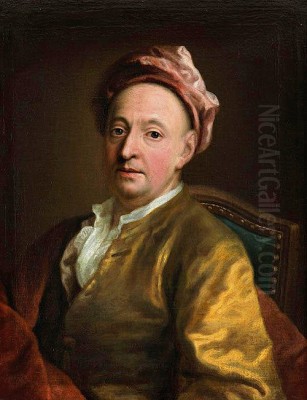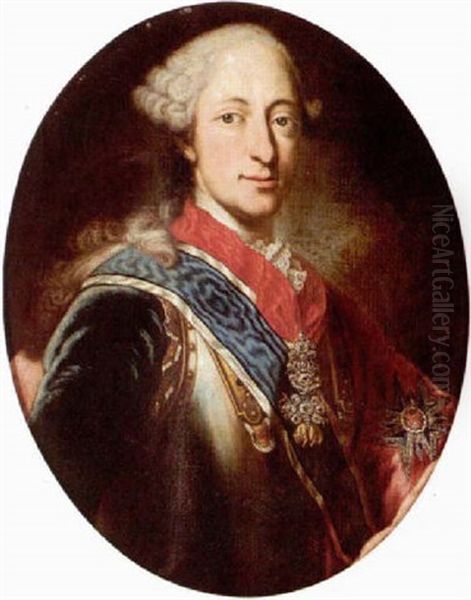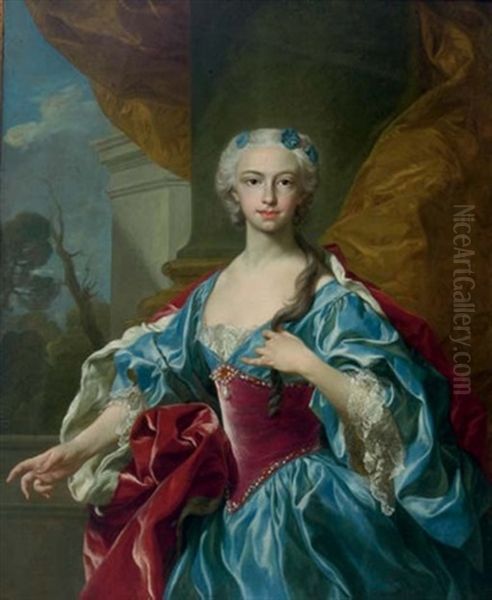Introduction: An Artist Between Nations

Georg Desmarées, born in Stockholm in 1697 and passing away in Munich in 1776, stands as a significant figure in the landscape of 18th-century European art. Though Swedish by birth, his career unfolded primarily within the German-speaking lands, particularly in Bavaria, where he rose to prominence as a highly sought-after court portraitist. His life and work bridge the artistic currents of Northern Europe, Italy, and France, culminating in a refined Rococo style that captured the likenesses and aspirations of the era's elite. Desmarées navigated the complex world of court patronage, leaving behind a legacy of elegant and insightful portraits that document the faces of power and society during a period of significant cultural and political change. His technical skill and ability to convey both status and a sense of individual presence made him a dominant force in South German portrait painting for decades.
Huguenot Roots and Early Training in Stockholm
Georg Desmarées hailed from a family of French Huguenot descent, a background shared by numerous artists and artisans who dispersed across Protestant Europe following the revocation of the Edict of Nantes. This heritage perhaps instilled a certain adaptability and cosmopolitan outlook that would serve him well in his itinerant career. Born in the Swedish capital, Stockholm, his initial artistic inclinations were nurtured within his own family. His first significant teacher was his maternal uncle, Martin Meytens the Elder (also known as Martin van Mijtens the Elder), a respected painter who had himself established a successful career.
Under Meytens' guidance, the young Desmarées would have received a solid grounding in the fundamentals of drawing and painting, likely focusing on the portrait genre that was his uncle's specialty. Stockholm at this time, while perhaps not the absolute centre of European art like Paris or Rome, possessed a vibrant cultural life, and training with an established artist like Meytens provided access to the standards and techniques prevalent in Northern Europe. This early instruction laid the foundation for the technical proficiency that would become a hallmark of Desmarées' mature work, emphasizing careful observation and skilled rendering.
The Journeyman Years: Broadening Horizons

Like many aspiring artists of his time, Desmarées understood the necessity of travel to further his education and expose himself to different artistic traditions. Leaving Stockholm, he embarked on a period of journeyman travel that significantly shaped his artistic development. His travels took him first to Amsterdam, a city that, while past its 17th-century Golden Age peak, remained an important commercial and cultural hub. Here, he could absorb the legacy of Dutch masters like Rembrandt van Rijn and Frans Hals, known for their penetrating psychological portraits and mastery of light and texture, though Desmarées' own style would ultimately lean towards a more courtly elegance.
From the Netherlands, he journeyed to Nuremberg, a historically significant German city with its own artistic traditions. More crucially, his travels led him south to Venice, a city renowned for its vibrant colour, painterly brushwork, and sophisticated artistic atmosphere. This Venetian sojourn proved particularly formative. Desmarées entered the studio of Giovanni Battista Piazzetta, one of the leading figures of the Venetian Settecento. Piazzetta was celebrated for his dramatic use of chiaroscuro, his rich, often earthy palette, and his ability to imbue figures with a sense of volume and presence. Studying with Piazzetta exposed Desmarées to the painterly freedom and chromatic richness of the Venetian school, elements that would subtly inform his later work, tempering the potentially stricter linearity of his Northern training.
Establishing a Reputation: Kassel and Early Commissions
The experience gained through travel and study, particularly the exposure to the sophisticated techniques of Venetian painting under Piazzetta, equipped Desmarées with the skills and confidence to seek significant patronage. His talent did not go unnoticed. An important early step in his career was securing a position at the court in Kassel. He worked for Landgrave Charles I of Hesse-Kassel, a ruler known for his interest in the arts and sciences. This appointment provided Desmarées with valuable experience in navigating the protocols and demands of courtly life.
Furthermore, his connections extended back to his homeland. Frederick I, who was Landgrave of Hesse-Kassel by marriage and later became King of Sweden, also employed Desmarées. Working for these high-ranking patrons allowed him to hone his skills in official portraiture, learning to balance the need for accurate likeness with the requirement to project an image of authority, dignity, and grace suitable for rulers and members of the aristocracy. These early court commissions were crucial in building his reputation and demonstrating his ability to satisfy the exacting standards of elite clientele, paving the way for even more prestigious appointments.
The Bavarian Court: Apex of a Career

The defining phase of Georg Desmarées' career began with his move to Munich, the capital of the Electorate of Bavaria. Here, he achieved his greatest success and solidified his position as one of the leading portrait painters in the German lands. He entered the service of the Wittelsbach dynasty, initially under Elector Charles Albert (later Holy Roman Emperor Charles VII). Charles Albert's reign was marked by grand ambitions and a flourishing court culture, providing ample opportunities for a skilled portraitist. Desmarées was appointed principal court painter, a prestigious role that placed him at the centre of artistic life in the Bavarian capital.
Following Charles Albert's death, Desmarées continued his service under the next Elector, Maximilian III Joseph. Max III Joseph, known as an enlightened ruler interested in reform and the arts, maintained Desmarées in his position. Throughout these decades in Munich, Desmarées produced a prolific number of portraits depicting the Electors, their families, visiting dignitaries, court officials, and members of the Bavarian aristocracy. His workshop became a major source for official imagery, disseminating the likenesses of the ruling family throughout the Electorate and beyond. This long tenure at the heart of the Bavarian court cemented his fame and influence.
Patronage Beyond Bavaria: Clemens August
Desmarées' reputation extended beyond the confines of Munich. He also found a significant patron in Clemens August of Bavaria, a member of the Wittelsbach family who held multiple ecclesiastical titles, most notably as the Prince-Archbishop and Elector of Cologne. Clemens August was renowned as one of the great builders and patrons of the Rococo era in Germany, commissioning magnificent palaces like Augustusburg and Falkenlust at Brühl.
Working for such a prominent and artistically discerning patron further enhanced Desmarées' prestige. His portraits of Clemens August capture the Elector's dual role as a powerful prince of the Church and a man of worldly sophistication, reflecting the opulent and complex culture of the German Rococo courts. These commissions demonstrate Desmarées' ability to adapt his style to suit different patrons while maintaining his characteristic elegance and technical finesse. His connection with Clemens August placed him within the network of artists and architects contributing to some of the most splendid artistic projects of the German Rococo.
The Rococo Style: Elegance and Refinement
Georg Desmarées worked firmly within the Rococo style, which dominated European art, particularly decorative arts and portraiture, for much of the mid-18th century. His approach to portraiture embodies many key characteristics of this aesthetic. Elegance and refinement are paramount; his sitters are presented with an air of grace and poise, often captured in sophisticated poses and adorned in luxurious attire. He paid meticulous attention to the rendering of fabrics – silks, velvets, lace, and brocades – capturing their textures and sheen with remarkable skill. This delight in surface detail and rich materials is typical of the Rococo sensibility.
His colour palette is generally bright and luminous, favouring harmonious combinations and avoiding the harsh dramatic contrasts of the preceding Baroque era. While influenced by the rich colours of his Venetian training under Piazzetta, Desmarées adapted this towards a lighter, more decorative effect suitable for courtly representation. His compositions are often dynamic yet balanced, employing gentle curves and diagonals to create a sense of movement and liveliness without sacrificing decorum. Compared to the sometimes more flamboyant or overtly sensual works of French Rococo masters like François Boucher or Jean-Honoré Fragonard, Desmarées' style often maintains a degree of formality and reserve appropriate for his German clientele.
French Influences and Courtly Ideals
The French court under Louis XIV and Louis XV set the standard for fashion, etiquette, and artistic taste across Europe in the 17th and 18th centuries. French portraiture, in particular, exerted a powerful influence, and Desmarées' work clearly shows an awareness of this tradition. The grand manner portraits of Hyacinthe Rigaud, known for their imposing compositions and detailed rendering of state robes and regalia, provided a model for official royal portraiture that resonated throughout European courts.
Similarly, the work of Nicolas de Largillière, another leading French portraitist, known for his rich colours and ability to capture the textures of luxurious fabrics, likely influenced Desmarées. The emphasis on presenting the sitter with an air of effortless sophistication, social grace, and inherent dignity – key elements of French court portraiture – are readily apparent in Desmarées' own works. He successfully adapted these French models to the specific context of the German courts, creating images that conveyed status and power while adhering to the prevailing Rococo aesthetic of elegance and charm. Artists like Jean-Marc Nattier, who specialized in allegorical portraits of court ladies, also contributed to the overall atmosphere of refined representation that Desmarées participated in.
Technical Mastery and Psychological Nuance
Beyond the stylistic conventions of the Rococo, Desmarées was a painter of considerable technical skill. His brushwork, while often refined and controlled, particularly in rendering faces and fine details, could also exhibit a certain fluency, especially in the handling of drapery and backgrounds, perhaps reflecting his Venetian training. He possessed a strong command of anatomy and perspective, allowing him to construct believable and well-proportioned figures within their settings. His handling of light is typically soft and diffused, flattering the sitter and contributing to the overall harmonious effect of the painting.
While Rococo portraiture often prioritized idealized elegance over deep psychological exploration, Desmarées' best works manage to convey a sense of the sitter's individual presence. Within the constraints of courtly decorum, he subtly captures nuances of expression and personality. His portraits are not mere masks of status; they often hint at the intelligence, temperament, or perhaps even the weariness of the individuals depicted. This ability to combine formal representation with a degree of psychological insight distinguishes his work and elevates it beyond simple flattery. He achieved a balance that satisfied the sitter's need for dignified representation while still offering a glimpse of the person behind the rank.
Representative Works: Faces of an Era
Desmarées' extensive oeuvre primarily consists of portraits. Among his most important works are the numerous official portraits of his primary patrons, the Bavarian Electors Charles VII Albert and Maximilian III Joseph. These images served a crucial state function, projecting the authority and lineage of the ruling dynasty. His depictions of Charles VII, for instance, capture the Elector (and briefly, Emperor) at the height of his political ambitions, adorned in armour or state robes. The portraits of Max III Joseph often convey the more enlightened and perhaps less overtly martial character of this later ruler.
His portrait of Clemens August of Bavaria is another key work, showcasing the Prince-Archbishop in his regalia, embodying the splendour of the ecclesiastical courts. Beyond these rulers, Desmarées painted numerous members of the aristocracy, court officials, and affluent members of society. A well-known example demonstrating his skill is the portrait of Unico Wilhelm van Wassenaer Obdam, a Dutch nobleman and diplomat, painted during the period 1741-1750. This work exemplifies Desmarées' ability to capture a sense of thoughtful intelligence and refined presence. His portraits of his own family, such as those depicting his wife and daughters, sometimes offer a more intimate and personal glimpse, perhaps less constrained by the demands of official representation.
Contemporaries in the German Lands
While Desmarées was a dominant figure, particularly in Southern Germany, he was part of a broader landscape of talented portrait painters working in the German-speaking lands during the 18th century. In Prussia, Antoine Pesne, a French-born artist, held a similarly prominent position as court painter to Frederick the Great in Berlin. Pesne's style, also rooted in French tradition, offers an interesting comparison point to Desmarées'.
Other notable German portraitists of the era included Johann Georg Ziesenis, who worked for various German courts and is known for his detailed and somewhat sober style. Later in the century, artists like Anton Graff gained prominence, moving towards a more Neoclassical sensibility. While perhaps less internationally famous than some of their French or Italian counterparts, these artists collectively created a rich visual record of German society and court life during the Rococo and early Enlightenment periods. Desmarées' position within this group is significant due to his long tenure, high-level patronage, and the consistent quality and elegance of his output, particularly representing the Bavarian court. The early work of Anton Raphael Mengs, before he fully embraced Neoclassicism, also overlaps with Desmarées' later period.
Venetian Connections and Comparisons
Desmarées' time in Venice and his study with Piazzetta left an indelible mark on his art, distinguishing him somewhat from artists trained solely in Northern or French traditions. Venice in the 18th century was a hub of artistic activity. Besides Piazzetta, other major figures included Giambattista Tiepolo, renowned for his vast, light-filled frescoes and oil paintings, and Rosalba Carriera, a celebrated female artist who achieved international fame for her exquisite pastel portraits.
While Desmarées' primary medium was oil on canvas, Carriera's success highlights the demand for portraiture across different media. The overall Venetian emphasis on colour, light, and painterly effects provided a rich environment for Desmarées. Though his style remained more controlled than the bravura brushwork of Tiepolo or the sometimes more overtly dramatic compositions of Piazzetta, the Venetian influence can be seen in the warmth of his palette and the sophisticated handling of light and texture in his best works. This connection added a layer of Italianate refinement to his essentially Northern European training.
Later Life and Enduring Legacy
Georg Desmarées remained active as a painter in Munich for many years, continuing to serve the Bavarian court under Max III Joseph. He witnessed the gradual shift in artistic tastes away from the high Rococo towards the emerging Neoclassical style, although his own work largely remained faithful to the aesthetic he had mastered. He died in Munich in 1776, bringing to a close a long and highly successful career that had spanned much of the 18th century.
His legacy rests primarily on his extensive body of portraiture. As the principal court painter in Bavaria for a significant period, he created the definitive images of its rulers and leading figures. His works are invaluable historical documents, offering insights into the personalities, fashions, and power structures of the German Rococo courts. Artistically, he represents a high point of Rococo portraiture in Germany, demonstrating a skillful synthesis of Swedish, German, Venetian, and French influences. His paintings are characterized by their technical assurance, elegant compositions, refined rendering of detail, and a subtle psychological sensitivity. While perhaps not an innovator on the scale of a Tiepolo or a Boucher, Desmarées was a master craftsman and a sensitive observer who perfectly captured the spirit of his age and clientele.
Conclusion: Chronicler of the Rococo Court
Georg Desmarées stands as a testament to the cosmopolitan nature of 18th-century European art. A Swede by birth, trained in Stockholm and Venice, he found his greatest success in Germany, becoming the preeminent portrait painter at the Bavarian court in Munich. His career exemplifies the importance of court patronage in the Rococo era and the intricate network of artistic exchange across the continent. Through his elegant, technically accomplished, and often insightful portraits, he not only documented the likenesses of Electors, Archbishops, and aristocrats but also captured the refined aesthetic and social values of his time. His work remains a vital visual resource for understanding the culture and personalities of the German Rococo, securing his place as a significant master of 18th-century portraiture.